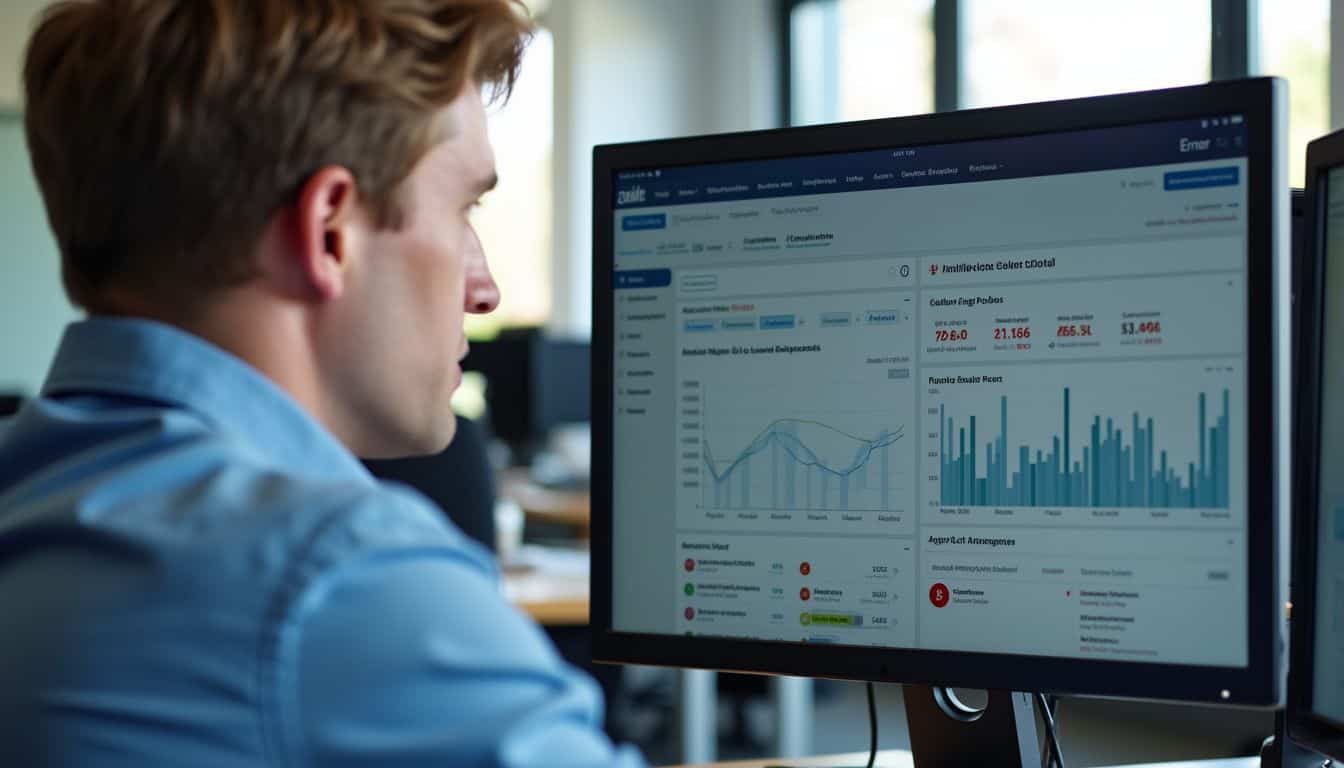Is your business drowning in data chaos? You’re not alone. Centralized data management can be a game-changer for companies big and small. 2 This blog post will show you how to tame your data beast and unlock growth opportunities. 1
Ready for some eye-opening insights? 3
Key Takeaways
Centralized data stores all company info in one place, making it easier to find, use, and protect. It boosts security, improves data quality, and helps businesses work faster.
Mixing centralized and decentralized approaches often works best. Use data lakes for key info and edge computing for speed. Tools like Starburst help access data from many sources.
Setting up a centralized system involves finding important data, creating rules for data use, and combining info from different places. ETL tools help merge data sources.
Top tools for managing centralized data include Tableau and Power BI for visuals, Slack for teamwork, and cloud storage like Amazon Redshift for flexible data handling.
A real e-commerce company grew sales by 30% in 6 months after centralizing data. They found 40% of customers left after one purchase and fixed the problem with targeted campaigns.
Table of Contents
Exploring Centralized Data

Centralized data is like a treasure chest for businesses. It’s where all the goodies – customer info, sales figures, and more – are stored in one spot.
Essential Characteristics

Centralized data storage packs a punch with its key traits. It’s like a well-organized library where all the books are in one place. Data gets saved in a neat, structured format – easy to find and use.
Think of it as your digital filing cabinet, but way cooler. It’s not just about storing info; it’s about making it work for you. 1
Security is a big deal here. Your data is locked up tight, like Fort Knox for your bytes. But it’s not just safe – it’s also super accessible to those who need it. Picture a team of data wizards, all working from the same playbook.
That’s the magic of centralized data. It’s a game-changer for businesses, especially when they centralized their data through Cetaris.
They can streamline operations and make smarter choices, faster. 2
Core Components

Centralized data systems have three main parts: storage, processing, and access. The storage part is like a big digital warehouse. It holds all the company’s data in one place. This could be a data lake or a data warehouse.
The processing part is the brain of the system. It cleans, sorts, and analyzes the data. Tools like ETL pipelines help with this. They move data from its source to the storage area. 1
The access part lets people use the data. It includes things like dashboards and reports. These help turn raw numbers into useful info. Data pipelines tie all these parts together.
They make sure data flows smoothly through the system. Good data pipelines can handle both batch and real-time data. This helps businesses react quickly to new info. 2 Next, let’s look at how centralized data management can help your business grow.
Advantages of Centralized Data Management

Centralized data management packs a punch for businesses. It’s like having a superpower – you can boost security, improve data quality, and make your operations run smoother… all at once!
Strengthen Data Security

Centralized data systems are powerful for improving security. Keeping all information in one location makes it easier to protect against threats. It’s like a fortress – one strong wall is better than many weak ones.
Cloud-hosted data takes this further, offering excellent protection that’s difficult to breach. 3
Data is the new oil, and centralization is the refinery. 4
DDoS attacks? No problem. Centralized systems can easily handle them. Plus, with everything in one place, you can establish strong rules for handling data. It’s like having a strict bouncer at the door of your data club – only authorized people get in.
Boost Data Integrity and Quality Control

Centralized data boosts data integrity like a champ. It’s the backbone of quality control, folks! With all your data in one spot, you can spot errors faster than a geek spots a typo in code.
No more conflicting info from different departments – it’s one source of truth, baby! This setup lets you run checks and balances across your entire data set. It’s like having a super-powered lint roller for your data…
zapping away inconsistencies and duplicates. 5
https://www.youtube.com/watch?v=jUTIiO-FVO0
But wait, there’s more! Centralized data makes it easier to set up rules and standards. You can create automated checks that flag weird data before it messes up your system. It’s like having a bouncer at the door of your data nightclub, keeping out the riffraff.
Plus, when you need to update or correct something, you only have to do it once. No more playing whack-a-mole with errors across multiple databases. That’s a win for accuracy and efficiency, my friends! 4
Enhance Operational Efficiency

Centralized data supercharges operational efficiency. It slashes data retrieval time, letting teams work faster and smarter. No more hunting through scattered files or bugging other departments for info.
Everything’s right there, ready to roll. This setup leads to smoother teamwork and quicker decision-making. 4
But wait, there’s more! Centralized data management helps businesses save big bucks. How? By cutting down on duplicate work and making resource allocation a breeze. Teams can spot trends, fix issues, and grab opportunities faster than ever.
It’s like giving your business a turbo boost – more done in less time, with fewer headaches. Now that’s what we call working smarter, not harder! 5
Comparing Centralized and Decentralized Data Management

Centralized and decentralized data management are like two sides of a coin. Each has its perks and quirks – centralized systems offer tight control and efficiency, while decentralized ones shine in data privacy and backup options.
Let’s dive into these data worlds and see how they stack up!
Control and Efficiency in Centralized Systems
Centralized systems put data in one place. This makes it easy to control and use. Think of it like a big library with one main desk. You can find books faster and keep track of them better.
Data teams run the show here. They make sure everything stays clean and correct. 6
These systems work well for business tasks. They help teams crunch numbers and spot trends quickly. It’s like having a super-smart assistant who knows where everything is. But there’s a catch.
You often need to ask the data team when you want info. This can slow things down sometimes. 7 Next, let’s look at how this compares to spread-out data systems.
A centralized system is like a well-oiled machine – efficient, controlled, and ready to power your business forward.
Data Privacy and System Redundancy in Decentralized Systems
Decentralized systems excel in data privacy. They distribute data across multiple locations, making it challenging for hackers to access everything simultaneously. It’s similar to hiding valuables in various places around your home instead of one central location.
This arrangement also ensures that if one component fails, the entire system remains operational. It’s impressive – your data remains more secure, and the system continues functioning even if issues arise. 4
There’s more to it, though. These systems are designed for longevity. They utilize numerous computers to store data copies. So if one malfunctions, others take over. It’s comparable to having backup performers – if one can’t perform, the performance continues.
This makes decentralized systems highly dependable. Let’s now discuss how to address the challenges of centralized data management. 7
Overcoming Centralization Challenges

Centralized data systems can hit snags. But don’t sweat it – there are ways to smooth things out. Mix and match approaches, keep your data in sync, and roll with tech changes.
Combine Centralized and Decentralized Approaches
Businesses today face a data dilemma. A mix of centralized and decentralized approaches often works best.
- Hybrid strategy: Companies can keep vital analytics data in one place while spreading out less-used info. This setup gives the best of both worlds. 8
- Data lakes and warehouses: Use these to store big chunks of data centrally. They act as a hub for your most important business intel. 7
- Edge computing: Put some data processing closer to where it’s made. This speeds things up and cuts down on network traffic.
- Cloud storage: Mix on-site servers with cloud options. It adds flexibility and helps handle sudden data spikes.
- Role-based access: Give folks only the data they need. It keeps things safe while letting teams work freely.
- Data governance framework: Set clear rules for data use across your company. It helps keep everyone on the same page.
- Single source of truth: Keep one main version of key data. But let teams work with copies for their specific needs.
- Distributed databases: Use these for data that changes a lot. They help avoid bottlenecks in busy systems.
Starburst is a tool that helps with this mixed approach. It gives quick access to all your data sources, no matter where they are. Let’s look at some top tools for managing centralized data.
Maintain Data Consistency
Combining centralized and decentralized approaches sets the stage for data consistency. Keeping data consistent across systems is crucial for accurate insights and decision-making.
- Use a single source of truth: Set up a master database that serves as the go-to place for all data. This cuts down on conflicting info and keeps everyone on the same page. 4
- Implement data validation rules: Create checks that catch errors before they enter the system. These rules can spot typos, wrong formats, or illogical entries.
- Automate data syncing: Use tools that update data across platforms in real-time. This keeps info fresh and reduces manual errors.
- Train your team: Teach staff how to input data correctly. Regular training sessions can boost data quality and cut down on mistakes.
- Conduct regular audits: Schedule frequent data checks to spot and fix inconsistencies. This helps maintain high data quality over time.
- Use version control: Keep track of data changes with version history. This lets you roll back to earlier versions if needed.
- Standardize data formats: Agree on common formats for dates, names, and other key fields. This makes it easier to merge data from different sources.
- Set up data governance: Create clear rules about who can access and change data. This helps prevent unauthorized tweaks that could mess up consistency.
- Use data cleansing tools: Employ software that can find and fix data issues automatically. These tools can save time and improve data accuracy.
- Monitor data quality metrics: Track key indicators of data health. This helps you spot trends and address issues before they become big problems. 2
Adapt to Technological Changes
Keeping data consistent is crucial, but it’s just the start. Tech changes fast, and your data system must keep up. New tools pop up all the time – like serverless computing and AI on edge devices.
These aren’t just fancy buzzwords. They’re game-changers that can make your data work smarter, not harder. 9
I’ve seen firsthand how adapting to tech shifts can give businesses an edge. Take cloud data warehousing, for example. Platforms like Amazon Redshift and Google BigQuery offer crazy scalability.
They let you crunch massive amounts of data in no time. But here’s the kicker – you need to stay on your toes. What works today might not cut it tomorrow. It’s all about being flexible and ready to pivot when new tech comes knocking. 10
Setting Up a Centralized Data Management System

Setting up a centralized data system is like building a digital fortress. It’s where all your company’s info lives – safe and sound. Want to know how to make it happen? Keep reading!
Pinpoint Critical Data Assets
Spotting key data assets is like finding gold in a digital mine. It’s all about knowing which bits of info pack the most punch for your business. Think customer details, sales figures, or product specs – the stuff that keeps your company ticking.
But here’s the kicker: not all data is created equal. You’ve got to sift through the noise and zero in on what really matters. 2
I’ve seen companies drown in data oceans, missing the gems right under their noses. That’s why smart businesses use tricks like ETL or ELT to sort the wheat from the chaff. 4 These methods help prep data based on what the bigwigs need to see.
And let me tell you, once you’ve nailed down those critical assets, you’re set for faster insights across the board. It’s like giving your whole team a pair of x-ray goggles for your data!
Build a Data Governance Framework
Data governance frameworks are the backbone of solid data management. They lay out clear rules for how a company handles its data. The Data Governance Institute (DGI) points to ten key parts that make up a good framework. 11 These parts cover everything from how data is stored to who can access it. 12
Building a framework isn’t just a top-down job. It works best when everyone who uses data gets involved. This bottom-up approach helps create buy-in across the company. Corporate data teams play a big role too.
They set standards for data quality and how different systems can work together. With a strong framework in place, businesses can make better choices based on trustworthy data.
Merge Multiple Data Sources
Merging data sources is like solving a giant puzzle. You’ve got pieces from all over – sales reports, customer feedback, website traffic – and you need to fit them together. That’s where ETL (Extract, Transform, Load) comes in handy.
It’s the glue that holds your data puzzle together. 2Zuar Runner makes this process a breeze. It’s a tool that automates data flow from various sources into one spot for analysis. This means you can mix and match data from different places without breaking a sweat.
Plus, it helps keep your info consistent across the board. No more headaches from conflicting numbers or outdated stats! 10
Top Tools for Managing Centralized Data

Let’s talk tools – the real MVPs of centralized data management. These bad boys can make or break your data game… and trust me, you want to be on the winning team.
Utilize Data Visualization Tools
Data viz tools are game-changers for businesses. They turn boring numbers into eye-catching charts and graphs. Imagine explaining complex data to your boss in seconds! That’s the power of these tools.
Tableau, Power BI, and Google Data Studio lead the pack in 2024. 13 They’re not just pretty – they’re smart too. Companies using them are 48% better at making data-driven choices. 13
But wait, there’s more! These tools aren’t just for looks. They help spot problems in your business fast. See where you’re wasting time or money. Find new ways to boost sales. It’s like having x-ray vision for your company.
Next up, we’ll dive into how these tools can supercharge your team’s work. 14
Employ Collaboration Tools
Collaboration tools are game-changers for centralized data management. Slack and Microsoft Teams rock the boat with instant messaging, video calls, and file sharing. 15 These tools let teams chat, brainstorm, and swap files in real-time.
It’s like having a virtual office where everyone’s just a click away.
But wait, there’s more! Project management tools like Asana and Trello help keep tasks on track. 16 They’re like digital to-do lists on steroids. Teams can assign tasks, set deadlines, and watch progress unfold.
It’s a breeze to see who’s doing what and when. These tools make teamwork smooth as butter, even when folks are spread across the globe.
Leverage Cloud Storage Solutions
Cloud storage solutions are game-changers for centralized data management. 2 They offer elastic scalability, cutting upfront costs and slashing maintenance headaches. 17 Tech enthusiasts, listen up! Tools like Amazon Redshift and Google BigQuery are turbocharging BI and ETL processes.
These cloud-based powerhouses let you crunch numbers faster than ever. 17
But wait a second! Before jumping in, weigh those migration costs carefully. Direct transfer expenses and potential downtime can add up quick. Still, the benefits often outweigh the challenges.
Cloud storage brings flexibility and performance that’ll make your data sing. Plus, it’s a lifesaver for handling big data and computer systems servicing.
Just keep in mind – smart planning is key to making the most of these cloud-powered wonders.
Case Study: Centralized Data’s Role in Business Expansion

Let’s dive into a real-world example. A mid-size e-commerce company faced a big problem. Their sales were flat, and they couldn’t figure out why. They had tons of data, but it was all over the place.
Customer info was in one system, sales data in another, and marketing stats somewhere else. It was a mess! They decided to centralize all their data. This move changed everything. 2
After centralizing, they saw the full picture. They found that 40% of their customers left after the first purchase. Yikes! But now they could do something about it. They used this info to create targeted campaigns.
They sent personalized emails and offers. The result? Customer loyalty shot up by 25%. Sales grew by 30% in just six months. The company expanded into new markets. All because they could finally see and use their data effectively.
It’s like they found a hidden treasure in their own backyard! 18
People Also Ask
What’s the big deal about centralized data?
Centralized data is like a treasure chest for businesses. It brings all your info together, making it easier to spot trends and make smart choices. Think of it as your company’s brain, storing everything from customer details to sales numbers. This setup helps you run smoother, serve customers better, and stay ahead of the pack.
How can centralized data boost my marketing game?
It’s a game-changer! With centralized data, you can create killer marketing campaigns. You’ll know your customers inside out, from their likes to their shopping habits. This lets you craft personalized messages that hit the mark. Plus, you can track how well your ads are doing and tweak them on the fly.
Is centralized data only for big companies?
No way! Businesses of all sizes can benefit. Even if you’re small, having your data in one place helps you work smarter, not harder. It’s like having a super-organized filing cabinet that does half the work for you. You’ll save time, spot opportunities faster, and grow your business without breaking a sweat.
What about keeping data safe and following rules?
Good question! Centralized data actually makes it easier to keep your info secure. You can set up tight controls on who sees what. It’s also a breeze to back up everything in one go. As for rules, having all your data in one spot makes it simpler to check if you’re playing by the book.
Can centralized data help me understand my customers better?
You bet! It’s like having a crystal ball. You can see the whole customer journey, from first click to final purchase. This bird’s-eye view helps you spot patterns and predict what customers might want next. It’s great for fine-tuning your service and keeping folks coming back for more.
How does centralized data fit into the bigger picture of business growth?
Think of centralized data as the secret sauce for growth. It helps you make decisions based on facts, not hunches. You can spot trends, test new ideas, and measure results all in one place. It’s like having a roadmap that shows you the fastest route to success. With centralized data, you’re not just growing – you’re growing smart.
References
^ https://risingwave.com/blog/7-eye-opening-examples-of-data-pipelines-guide-2024/ (2024-08-11)
^ https://www.kohezion.com/blog/data-centralization
^ https://info.cgcompliance.com/blog/how-centralized-data-improves-the-health-care-industry (2019-11-20)
^ https://www.glueup.com/blog/centralized-data-management (2024-04-26)
^ https://udtonline.com/what-are-the-benefits-of-centralized-data-management/
^ https://www.researchgate.net/publication/273338351_Centralizing_Data_Management_with_Considerations_of_Uncertainty_and_Information-Based_Flexibility
^ https://inclusioncloud.com/insights/blog/centralized-decentralized-data/
^ https://www.starburst.io/data-glossary/centralized-data/
^ https://www.sciencedirect.com/science/article/pii/S2772503024000021
^ https://www.teradata.com/insights/data-platform/what-is-data-centralization (2024-05-29)
^ https://atlan.com/data-governance-framework/ (2024-02-29)
^ https://www.alation.com/blog/steps-for-building-data-governance-strategy/ (2021-12-16)
^ https://www.imensosoftware.com/blog/10-best-data-visualization-tools-for-2024/ (2024-05-25)
^ https://www.toptal.com/designers/data-visualization/data-visualization-tools
^ https://www.titanfile.com/blog/collaboration-tools-for-business/
^ https://www.nimblework.com/blog/best-collaboration-software-tools/
^ https://saratogasoftware.com/how-to-leverage-cloud-solutions/
^ https://fastercapital.com/content/Centralized-data-analytics–The-Role-of-Centralized-Data-Analytics-in-Driving-Business-Growth.html
